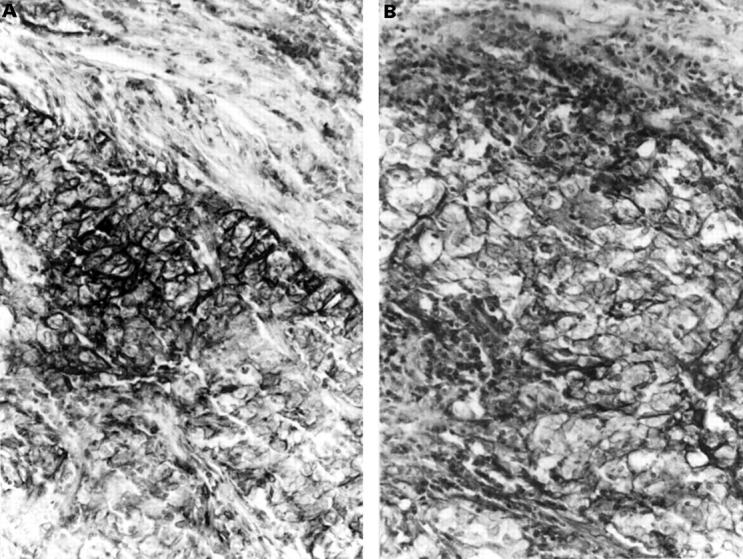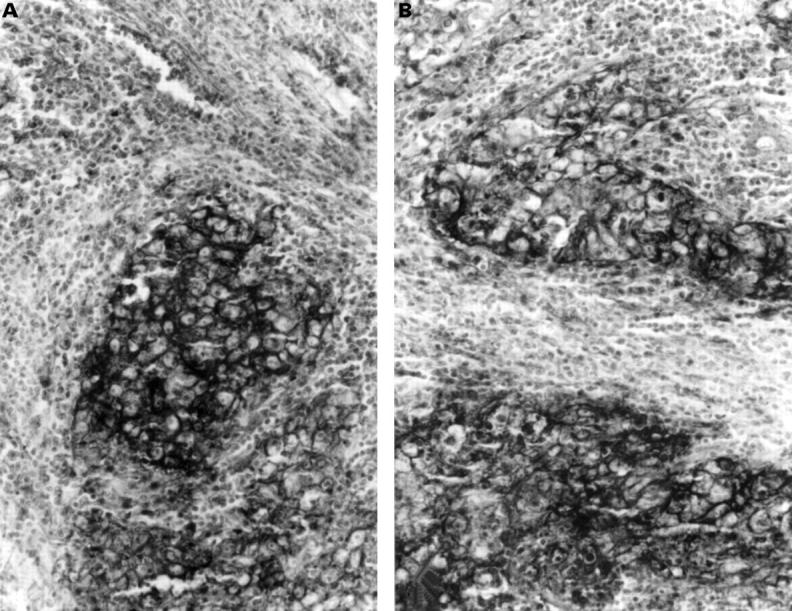Abstract
Aims—To examine the expression of HLA-DR and ß2 microglobulin in medullary carcinoma and atypical medullary carcinoma of the breast to determine if the effective presentation of tumour antigens to the immune system can differentiate between these two histopathologically similar entities.
Methods—Expression of HLA-DR and ß2 microglobulin was examined by immunohistochemical methods in five samples of medullary carcinoma of the breast, which has a relatively favourable prognosis, six samples of atypical medullary carcinoma of the breast, which has a prognosis closer to that of regular invasive duct carcinoma, and 20 samples of invasive duct carcinomas, 10 with an accompanying lymphocytic infiltrate.
Results—A positive and significant correlation was found between tumour type and both HLA-DR and ß2 microglobulin expression. Expression was most prominent in medullary carcinoma, followed by atypical medullary carcinoma and invasive duct carcinoma with and without lymphocytic infiltrates. The mean intensity and percentage of HLA-DR tumour immunostaining were significantly higher in medullary carcinoma than in the other three tumour groups, as was the mean intensity of ß2 microglobulin immunostaining. Mean percentage of ß2 microglobulin immunostaining was significantly higher in medullary carcinoma than in invasive duct carcinoma without lymphocytic infiltrates, and showed a trend to increase from invasive duct carcinoma with lymphocytic infiltrates to atypical medullary carcinoma and medullary carcinoma.
Conclusions—Medullary carcinoma and atypical medullary carcinoma of the breast differ in their expression of HLA-DR and ß2 microglobulin. The relatively favourable prognosis of medullary carcinoma of the breast may be related to effective tumour antigen presentation to the immune system through MHC-I and MHC-II expression. Immunotherapy aimed at MHC-I and MHC-II induction might have a beneficial effect in breast cancer.
Key Words: medullary carcinoma of the breast • HLA-DR expression • ß2 microglobulin expression
Full Text
The Full Text of this article is available as a PDF (260.9 KB).

Figure 1 Prominent, predominantly membranous, immunopositivity for HLA-DR (A) and ß2 microglobulin (B) in medullary carcinoma of the breast. Immunopositivity was also noted in some of the surrounding lymphocytes.

Figure 2 Widespread immunopositivity for HLA-DR (A) and ß2 microglobulin (B) in medullary carcinoma of the breast. The surrounding lymphocytic infiltrate appears predominantly negative.
Selected References
These references are in PubMed. This may not be the complete list of references from this article.
- Balch C. M., Riley L. B., Bae Y. J., Salmeron M. A., Platsoucas C. D., von Eschenbach A., Itoh K. Patterns of human tumor-infiltrating lymphocytes in 120 human cancers. Arch Surg. 1990 Feb;125(2):200–205. doi: 10.1001/archsurg.1990.01410140078012. [DOI] [PubMed] [Google Scholar]
- Ben-Ezra J., Sheibani K. Antigenic phenotype of the lymphocytic component of medullary carcinoma of the breast. Cancer. 1987 Jun 15;59(12):2037–2041. doi: 10.1002/1097-0142(19870615)59:12<2037::aid-cncr2820591212>3.0.co;2-g. [DOI] [PubMed] [Google Scholar]
- Bernard D. J., Courjal F., Maurizis J. C., Bignon Y. J., Chollet P., Plagne R. Effect of epidermal growth factor in HLA class I and class II transcription and protein expression in human breast adenocarcinoma cell lines. Br J Cancer. 1992 Jul;66(1):88–92. doi: 10.1038/bjc.1992.222. [DOI] [PMC free article] [PubMed] [Google Scholar]
- Bernard D., Maurizis J. C., Rusé F., Chassagne J., Chollet P., Sauvezie B., de Latour M., Plagne R. Presence of HLA-D/DR antigens on the membrane of breast tumour cells. Clin Exp Immunol. 1984 Apr;56(1):215–221. [PMC free article] [PubMed] [Google Scholar]
- Brunner C. A., Gokel J. M., Riethmüller, Johnson J. P. Expression of HLA-D subloci DR and DQ by breast carcinomas is correlated with distinct parameters of favourable prognois. Eur J Cancer. 1991;27(4):411–416. doi: 10.1016/0277-5379(91)90374-m. [DOI] [PubMed] [Google Scholar]
- Bártek J., Petrek M., Vojtesek B., Bártková J., Kovarík J., Rejthar A. HLA-DR antigens on differentiating human mammary gland epithelium and breast tumours. Br J Cancer. 1987 Dec;56(6):727–733. doi: 10.1038/bjc.1987.278. [DOI] [PMC free article] [PubMed] [Google Scholar]
- Cohen P. J., Lotze M. T., Roberts J. R., Rosenberg S. A., Jaffe E. S. The immunopathology of sequential tumor biopsies in patients treated with interleukin-2. Correlation of response with T-cell infiltration and HLA-DR expression. Am J Pathol. 1987 Nov;129(2):208–216. [PMC free article] [PubMed] [Google Scholar]
- Concha A., Cabrera T., Ruiz-Cabello F., Garrido F. Can the HLA phenotype be used as a prognostic factor in breast carcinomas? Int J Cancer Suppl. 1991;6:146–154. doi: 10.1002/ijc.2910470726. [DOI] [PubMed] [Google Scholar]
- Concha A., Esteban F., Cabrera T., Ruiz-Cabello F., Garrido F. Tumor aggressiveness and MHC class I and II antigens in laryngeal and breast cancer. Semin Cancer Biol. 1991 Feb;2(1):47–54. [PubMed] [Google Scholar]
- Doyle A., Martin W. J., Funa K., Gazdar A., Carney D., Martin S. E., Linnoila I., Cuttitta F., Mulshine J., Bunn P. Markedly decreased expression of class I histocompatibility antigens, protein, and mRNA in human small-cell lung cancer. J Exp Med. 1985 May 1;161(5):1135–1151. doi: 10.1084/jem.161.5.1135. [DOI] [PMC free article] [PubMed] [Google Scholar]
- Ghosh A. K., Moore M., Street A. J., Howat J. M., Schofield P. F. Expression of HLA-D sub-region products on human colorectal carcinoma. Int J Cancer. 1986 Oct 15;38(4):459–464. doi: 10.1002/ijc.2910380402. [DOI] [PubMed] [Google Scholar]
- Goodenow R. S., Vogel J. M., Linsk R. L. Histocompatibility antigens on murine tumors. Science. 1985 Nov 15;230(4727):777–783. doi: 10.1126/science.2997918. [DOI] [PubMed] [Google Scholar]
- Holden C. A., Sanderson A. R., MacDonald D. M. Absence of human leukocyte antigen molecules in skin tumors and some cutaneous appendages: evidence using monoclonal antibodies. J Am Acad Dermatol. 1983 Dec;9(6):867–871. doi: 10.1016/s0190-9622(83)70200-8. [DOI] [PubMed] [Google Scholar]
- Hurlimann J., Saraga P. Mononuclear cells infiltrating human mammary carcinomas: immunohistochemical analysis with monoclonal antibodies. Int J Cancer. 1985 Jun 15;35(6):753–762. doi: 10.1002/ijc.2910350610. [DOI] [PubMed] [Google Scholar]
- Jabrane-Ferrat N., Faille A., Loiseau P., Poirier O., Charron D., Calvo F. Effect of gamma interferon on HLA class-I and -II transcription and protein expression in human breast adenocarcinoma cell lines. Int J Cancer. 1990 Jun 15;45(6):1169–1176. doi: 10.1002/ijc.2910450630. [DOI] [PubMed] [Google Scholar]
- Kaufman J. F., Auffray C., Korman A. J., Shackelford D. A., Strominger J. The class II molecules of the human and murine major histocompatibility complex. Cell. 1984 Jan;36(1):1–13. doi: 10.1016/0092-8674(84)90068-0. [DOI] [PubMed] [Google Scholar]
- Koretz K., Moldenhauer G., Majdic O., Möller P. Correlation of HLA-D/Ii antigen expression in breast carcinoma with local lymphohistiocytic infiltration reveals considerable dysregulation in a subset of tumors. Int J Cancer. 1989 Nov 15;44(5):816–822. doi: 10.1002/ijc.2910440512. [DOI] [PubMed] [Google Scholar]
- Lampson L. A., Fisher C. A., Whelan J. P. Striking paucity of HLA-A, B, C and beta 2-microglobulin on human neuroblastoma cell lines. J Immunol. 1983 May;130(5):2471–2478. [PubMed] [Google Scholar]
- Lucin K., Iternicka Z., Jonjić N. Prognostic significance of T-cell infiltrates, expression of beta 2-microglobulin and HLA-DR antigens in breast carcinoma. Pathol Res Pract. 1994 Dec;190(12):1134–1140. doi: 10.1016/s0344-0338(11)80439-5. [DOI] [PubMed] [Google Scholar]
- Matory Y. L., Chen M., Dorfman D. M., Williams A., Goedegebuure P. S., Eberlein T. J. Antitumor activity of three mouse mammary cancer cell lines after interferon-gamma gene transfection. Surgery. 1995 Aug;118(2):251–256. doi: 10.1016/s0039-6060(05)80331-9. [DOI] [PubMed] [Google Scholar]
- Mepham B. L., Frater W., Mitchell B. S. The use of proteolytic enzymes to improve immunoglobulin staining by the PAP technique. Histochem J. 1979 May;11(3):345–357. doi: 10.1007/BF01005033. [DOI] [PubMed] [Google Scholar]
- Möller P., Mattfeldt T., Gross C., Schlosshauer P., Koch A., Koretz K., Moldenhauer G., Kaufmann M., Otto H. F. Expression of HLA-A, -B, -C, -DR, -DP, -DQ, and of HLA-D-associated invariant chain (Ii) in non-neoplastic mammary epithelium, fibroadenoma, adenoma, and carcinoma of the breast. Am J Pathol. 1989 Jul;135(1):73–83. [PMC free article] [PubMed] [Google Scholar]
- Müller C., Ziegler A., Muller C., Hadam M., Waller H. D., Wernet P., Müller G. Divergent expression of HLA-DC/MB, -DR, and -SB region products on normal and pathological tissues as detected by monoclonal antibodies. Immunobiology. 1985 Apr;169(3):228–249. doi: 10.1016/s0171-2985(85)80036-x. [DOI] [PubMed] [Google Scholar]
- Natali P. G., Giacomini P., Bigotti A., Imai K., Nicotra M. R., Ng A. K., Ferrone S. Heterogeneity in the expression of HLA and tumor-associated antigens by surgically removed and cultured breast carcinoma cells. Cancer Res. 1983 Feb;43(2):660–668. [PubMed] [Google Scholar]
- Pérez M., Cabrera T., Lopez Nevot M. A., Gomez M., Peran F., Ruiz-Cabello F., Garrido F. Heterogeneity of the expression of class I and II HLA antigens in human breast carcinoma. J Immunogenet. 1986 Apr-Jun;13(2-3):247–253. doi: 10.1111/j.1744-313x.1986.tb01108.x. [DOI] [PubMed] [Google Scholar]
- Rapin V., Contesso G., Mouriesse H., Bertin F., Lacombe M. J., Piekarski J. D., Travagli J. P., Gadenne C., Friedman S. Medullary breast carcinoma. A reevaluation of 95 cases of breast cancer with inflammatory stroma. Cancer. 1988 Jun 15;61(12):2503–2510. doi: 10.1002/1097-0142(19880615)61:12<2503::aid-cncr2820611219>3.0.co;2-3. [DOI] [PubMed] [Google Scholar]
- Ridolfi R. L., Rosen P. P., Port A., Kinne D., Miké V. Medullary carcinoma of the breast: a clinicopathologic study with 10 year follow-up. Cancer. 1977 Oct;40(4):1365–1385. doi: 10.1002/1097-0142(197710)40:4<1365::aid-cncr2820400402>3.0.co;2-n. [DOI] [PubMed] [Google Scholar]
- Rubens J. R., Lewandrowski K. B., Kopans D. B., Koerner F. C., Hall D. A., McCarthy K. A. Medullary carcinoma of the breast. Overdiagnosis of a prognostically favorable neoplasm. Arch Surg. 1990 May;125(5):601–604. doi: 10.1001/archsurg.1990.01410170047010. [DOI] [PubMed] [Google Scholar]
- Rubin J. T., Elwood L. J., Rosenberg S. A., Lotze M. T. Immunohistochemical correlates of response to recombinant interleukin-2-based immunotherapy in humans. Cancer Res. 1989 Dec 15;49(24 Pt 1):7086–7092. [PubMed] [Google Scholar]
- Schrier P. I., Bernards R., Vaessen R. T., Houweling A., van der Eb A. J. Expression of class I major histocompatibility antigens switched off by highly oncogenic adenovirus 12 in transformed rat cells. 1983 Oct 27-Nov 2Nature. 305(5937):771–775. doi: 10.1038/305771a0. [DOI] [PubMed] [Google Scholar]
- Tanaka K., Isselbacher K. J., Khoury G., Jay G. Reversal of oncogenesis by the expression of a major histocompatibility complex class I gene. Science. 1985 Apr 5;228(4695):26–30. doi: 10.1126/science.3975631. [DOI] [PubMed] [Google Scholar]
- Taylor C. R. Immunoperoxidase techniques: practical and theoretical aspects. Arch Pathol Lab Med. 1978 Mar;102(3):113–121. [PubMed] [Google Scholar]
- Tsuda H., Hirohashi S., Higuchi K., Shimosato Y. Beta-2-microglobulin expression in relation to amplification of oncogenes and prognosis in breast carcinoma. Histopathology. 1990 May;16(5):500–502. doi: 10.1111/j.1365-2559.1990.tb01552.x. [DOI] [PubMed] [Google Scholar]
- Vogel J., Tanaka K., Hoekzema G. S., Jay G. Experimental strategies for modification of histocompatibility antigens in tumor cells. Cancer Metastasis Rev. 1987;6(4):677–683. doi: 10.1007/BF00047474. [DOI] [PubMed] [Google Scholar]
- Wargotz E. S., Silverberg S. G. Medullary carcinoma of the breast: a clinicopathologic study with appraisal of current diagnostic criteria. Hum Pathol. 1988 Nov;19(11):1340–1346. doi: 10.1016/s0046-8177(88)80290-9. [DOI] [PubMed] [Google Scholar]
- Weiss M. A., Michael J. G., Pesce A. J., DiPersio L. Heterogeneity of beta 2-microglobulin in human breast carcinoma. Lab Invest. 1981 Jul;45(1):46–57. [PubMed] [Google Scholar]
- Wintzer H. O., Benzing M., von Kleist S. Lacking prognostic significance of beta 2-microglobulin, MHC class I and class II antigen expression in breast carcinomas. Br J Cancer. 1990 Aug;62(2):289–295. doi: 10.1038/bjc.1990.280. [DOI] [PMC free article] [PubMed] [Google Scholar]
- Zuk J. A., Walker R. A. HLA class II sublocus expression in benign and malignant breast epithelium. J Pathol. 1988 Aug;155(4):301–309. doi: 10.1002/path.1711550405. [DOI] [PubMed] [Google Scholar]
- Zuk J. A., Walker R. A. Immunohistochemical analysis of HLA antigens and mononuclear infiltrates of benign and malignant breast. J Pathol. 1987 Aug;152(4):275–285. doi: 10.1002/path.1711520406. [DOI] [PubMed] [Google Scholar]


